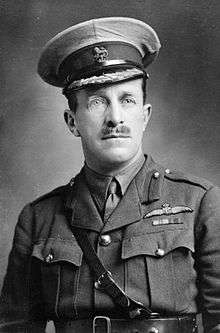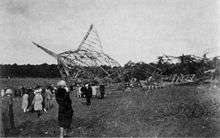Sefton Brancker
| Sir William Sefton Brancker | |
|---|---|
 Sefton Brancker, c.1915–18 | |
| Born |
22 March 1877 Woolwich, Kent, England |
| Died |
5 October 1930 (aged 53) Beauvais, France |
| Allegiance | United Kingdom |
| Service/branch |
British Army (1896–18) Royal Air Force (1918–19) |
| Years of service | 1896–1919 |
| Rank | Air Vice Marshal |
| Commands held |
Master-General of Personnel (1918–19) Controller-General of Equipment (1918) HQ RFC Middle East (1917) Palestine Brigade (1917) Northern (Training) Brigade (1915–16) No. 3 Wing (1915) |
| Battles/wars |
Second Boer War First World War |
| Awards |
Knight Commander of the Order of the Bath Air Force Cross Officer of the Legion of Honour (France) Order of St. Vladimir, 4th Class (Russia) Order of Saint Stanislaus, 1st Class (Russia) Commander of the Order of the Crown (Italy) Commander of the Order of Leopold (Belgium) |
| Other work | British Director of Civil Aviation |
Air Vice Marshal Sir William Sefton Brancker, KCB, AFC (22 March 1877 – 5 October 1930), commonly known as Sir Sefton Brancker, was a senior officer of the Royal Flying Corps and later Royal Air Force, and pioneer in British civil and military aviation.
Early life
Sefton Brancker was born on 22 March 1877, at Woolwich in Kent. His parents were Colonel William Godefroy Brancker and Hester Adelaide, the daughter of Major General Henry Charles Russel. Brancker grew up as the elder of two brothers and their father died in 1885. From 1891-94, the young Brancker attended Bedford School. The Branckers were a long-established Anglo-German family that had lived in England for several generations.
Military career
Brancker was trained for the British Army at Woolwich, joining the Royal Artillery in 1896.[1] He served in the Second Boer War and later for a number of years in India, where he made his first flight in 1910.[2] On 18 June 1913 he was awarded the Royal Aero Club's Aviator's Certificate no. 525.[1]
During the First World War, Brancker held important administrative posts in the Royal Flying Corps and later the Royal Air Force including Director of Military Aeronautics.[1] In late 1915 a brigade system was introduced in the RFC and Brancker was promoted to brigadier general and appointed to command the Northern Training Brigade with his headquarters in Birmingham. This appointment was to be short-lived as in early 1916 Brancker was appointed Director of Air Organisation in London.[3] In 1917, Brancker briefly served as the General Officer Commanding Royal Flying Corps's Palestine Headquarters and then its Middle East headquarters.[1] Promoted to major general in 1918, he became Controller-General of Equipment in January of that year and Master-General of Personnel in August 1918.[1] The following year, he was appointed Knight Commander of the Order of the Bath and, with the introduction of RAF-specific ranks, he became an air vice marshal.[1]
Civil aviation
On 11 May 1922 he was made Director of Civil Aviation,[1] and worked assiduously to stimulate UK interest in the subject with both local authorities and flying clubs. He encouraged Manchester and other cities to construct municipal airports and airfields. He participated in several long-distance survey flights, notably with Alan Cobham. He was an ardent supporter of the development of British civilian air services connecting London to British colonies and dominions overseas.[4]
Sir Sefton was chairman of the Royal Aero Club's (RAeC) Racing Committee from 1921 to 1930 and his dynamic leadership led to the RAeC forming the Light Aero Club scheme in 1925, which helped provide the UK clubs with examples of such new and improved aircraft types as the de Havilland Moth and Avro Avian.
Death

Together with Lord Thomson, the Air Minister, Brancker was killed when the airship R101 crashed near Beauvais France on 5 October 1930, during its maiden voyage to India.[1][4]
Legacy
In 1952 British European Airways named its 'Pionair' (Douglas DC-3) G-AKNB "Sir Sefton Brancker" to mark his substantial contribution to the development of British Aviation.
In 1996 British Airways (BA) named one of its newly delivered Boeing 777's "Sir William Sefton Branker" [sic] in recognition of his work. Other 777s in the BA fleet were named after aviation pioneers, for example "Wilbur and Orville Wright" and "Sir Frank Whittle." The aircraft (G-ZZZB) no longer carries Sir Sefton's name, aircraft names having been removed from the BA fleet since the short-lived 1997 Utopia re-branding.
Kenmore Park housing estate in Kenton Harrow has a number of its roads named after aviators including Brancker.
References
- Footnotes
- Bibliography
- Pirie, Gordon H. Air Empire: British Imperial Civil Aviation, 1919–1939. Manchester: Manchester University Press, 2009.
- Raleigh, Walter. The War In The Air: Being the Story of The part played in the Great War by The Royal Air Force: Vol I. Oxford:Clarendon Press, 1922.
Further reading
- Sir Sefton Brancker by Norman Macmillan, William Heinemann Ltd, London, 1935
- Heavenly Adventurer: a biography of Sir Sefton Brancker by Basil Collier, London, 1959
- Air Days, John F. Leeming, Harrap, London, 1936
External links
| Wikimedia Commons has media related to Sefton Brancker. |
- This article incorporates text from The Modern World Encyclopædia: Illustrated (1935); out of UK copyright as of 2005.
- Oxford Dictionary of National Biography – Brancker, Sir William Sefton (requires login)
| Military offices | ||
|---|---|---|
| New title Directorate established |
Assistant Director of Military Aeronautics Deputy Director from March 1915 1913–1915 |
Succeeded by John Fulton |
| Preceded by John Higgins |
Officer Commanding No. 3 Wing August – December 1915 |
Succeeded by Unknown |
| New title Brigade established |
Brigadier-General Commanding Northern (Training) Brigade December 1915 – February 1916 |
Succeeded by Unknown |
| New title Post created |
Director of Air Organization 1916–1917 |
Succeeded by Lionel Charlton |
| New title | Deputy Director-General of Military Aeronautics February – November 1917 |
Succeeded by Edward Ellington |
| Preceded by Geoffrey Salmond |
Officer Commanding Palestine Brigade November – December 1917 |
Succeeded by Amyas Borton |
| General Officer Commanding HQ RFC Middle East November – December 1917 |
Succeeded by Geoffrey Salmond | |
| New title Air Council established |
RAF Controller-General of Equipment January – August 1918 |
Succeeded by Edward Ellington |
| Preceded by Sir Godfrey Paine |
RAF Master-General of Personnel 1918–1919 |
Vacant Title next held by Cecil LambertAs Director of Personnel |
| Government offices | ||
| Preceded by Sir Frederick Sykes As Controller |
Director of Civil Aviation 1922–1930 |
Succeeded by Sir Francis Shelmerdine |
| Notes and references | ||
| 1. A complete list of Brancker's military appointments can be found in Appendix I to Brancker, Sefton (1935). Macmillan, Norman, ed. Sir Sefton Brancker. London: William Heinemann Ltd. pp. 420 to 425. | ||